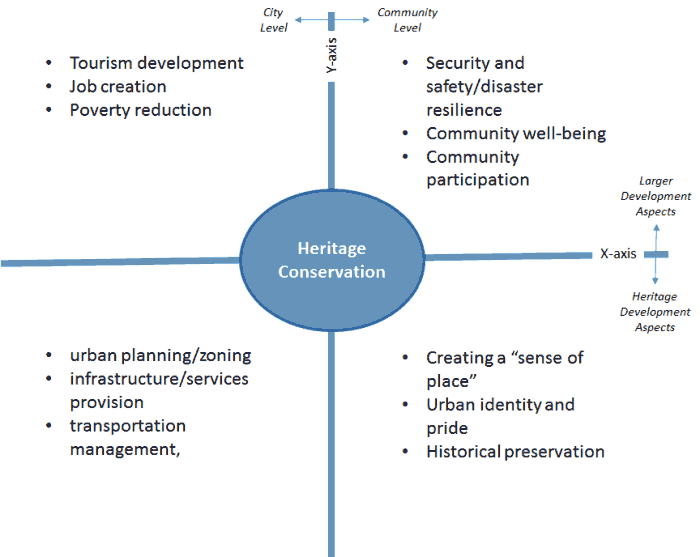 |
Hari Srinivas |
|
Policy Analysis Series E-100. April 2020.
|

Abstract:
Heritage conservation, often perceived as secondary to more urgent urban challenges such as infrastructure development and poverty alleviation, plays a vital role in sustainable urban development. This paper explores the justifications and implications of heritage conservation strategies, emphasizing the need for both tangible and intangible asset preservation. It argues that integrating heritage policies into broader urban planning processes fosters local economic revitalization, strengthens community identity and pride, enhances well-being and human security, and contributes to long-term sustainability goals. Drawing on a policy framework that spans both community and city levels, the paper highlights the necessity of community participation, economic linkage, cultural preservation, and localization of strategies to ensure the success of conservation initiatives.
Keywords:
Heritage Conservation, Urban Identity, Community Participation, Sustainable Development,
Intangible Heritage, Economic Revitalization, Human Security, Urban Planning
|
W hy heritage conservation? Conserving urban heritage - historical buildings, festivals, art forms, dance, music, sculpture etc. - may seem less of a priority compared to more pressing issues such as infrastrcture development, poverty alleviation or job creation.
But, in the long run, effective conservation of heritage resources not only helps in preserving and safegaurding the resources, but also in revitalizing local economies, and in bringing about a sense of identity, pride and belonging to residents.
Good heritage conservation strategies require (a) better appreciation of the value of heritage assets (both tangible and intangible), and (b) integration of such strategies within the larger processes of planning and development of a city or urban area.
Heritage preservation and conservation policies -
- help in building urban identity and pride in its residents.
- go beyond just resorting and preserving historical assets,
- lead to well-being and security, through broad community participation and involvement.
- generate opportunities for job creation and poverty alleviation
- broadly, and in the long-run, help achieve sustainability goals as well.
 Figure 1: Heritage Conservation Policy Dimensions
Figure 1: Heritage Conservation Policy Dimensions
Figure 1 above illustrates the dimensions of heritage conservation that accrue not only for heritage assets, but also to larger development aspects (across the x-axis). Distinctions across the y-axis on the other hand show the benefits at the community level, and at the city levels.
Some of the key aspects of the four quadrants in the figure above illustrate some of the contributing factors to heritage conservation, but are not limited to these alone, and there are several other aspects as well - geographical information systems and mapping, fianncial instruments etc. - that have not been included.
Larger developmental aspects of heritage conservation strategies at the city level cover issues such as tourism development, job creation and poverty alleviation. At the community level, priorities change to security and safety (including disaster resilience), community well-being and community participation.
Heritage aspects at the city level cover issues such as urban planning/zoning, infrastructure/services provision, and transportation management. At the community level, heritage conservation help in creating a "sense of place", urban identity and pride and specific perservation of the comunity.
Using the above discussion, a series of eight sections are presented below that outline the justifications and implications of heritage conservation strategies:
- Heritage conservation and urban identity / pride: A good heritage conservation strategy is critical to build a strong urban identity and pride in our cities and towns.
- Heritage conservation is more than history: A good heritage conservation strategy incorporates all aspects of a region's heritage - historical, but also natural and cultural.
- Heritage conservation needs community participation and involvement: A good heritage conservation strategy requires the active participation and involvement of the local community in all aspects of its development and implementation.
- Heritage conservation leads to well-being / human security: A good heritage conservation strategy should also have well-being and human security as some of its eventual goals for the local community.
- Heritage conservation is critical to job creation and poverty alleviation: A good heritage conservation strategy should be linked to the local economy, in order to create jobs and alleviate poverty - particularly in developing countries
- Heritage conservation helps preserve intangible local cultures: A good heritage conservation strategy looks at both tangible and intangible heritage resources in an integrated manner
- Heritage conservation strongly influences sustainability goals: A good heritage conservation strategy inherently takes into account, the long term sustainability goals of the region
- Heritage conservation through localization, contextualization& and customization: A good heritage conservation strategy needs to be localized, contextualized and customized in order for it to succeed and deliver on its goals.
Sustainable Development Goals and Heritage
Where is heritage conservation addressed in the new Sustainable Development Goals (SDGs)*?
The 17 SDGs have a number of targets embedded within them focusing on heritage conservation themes and issues.
Goal 11 aims to “Make cities and human settlements inclusive, safe, resilient and sustainable.” This goal envisions sustainable, livable urban centers with universal access to green spaces. There are a total of 10 targets to be achieved under this Goal.
Target 11.4 specifically calls for “Strengthening efforts to protect and safeguard the world’s cultural and natural heritage”
How can this target be achieved?
* See GDRC's feature, SDGs Dashboard
|